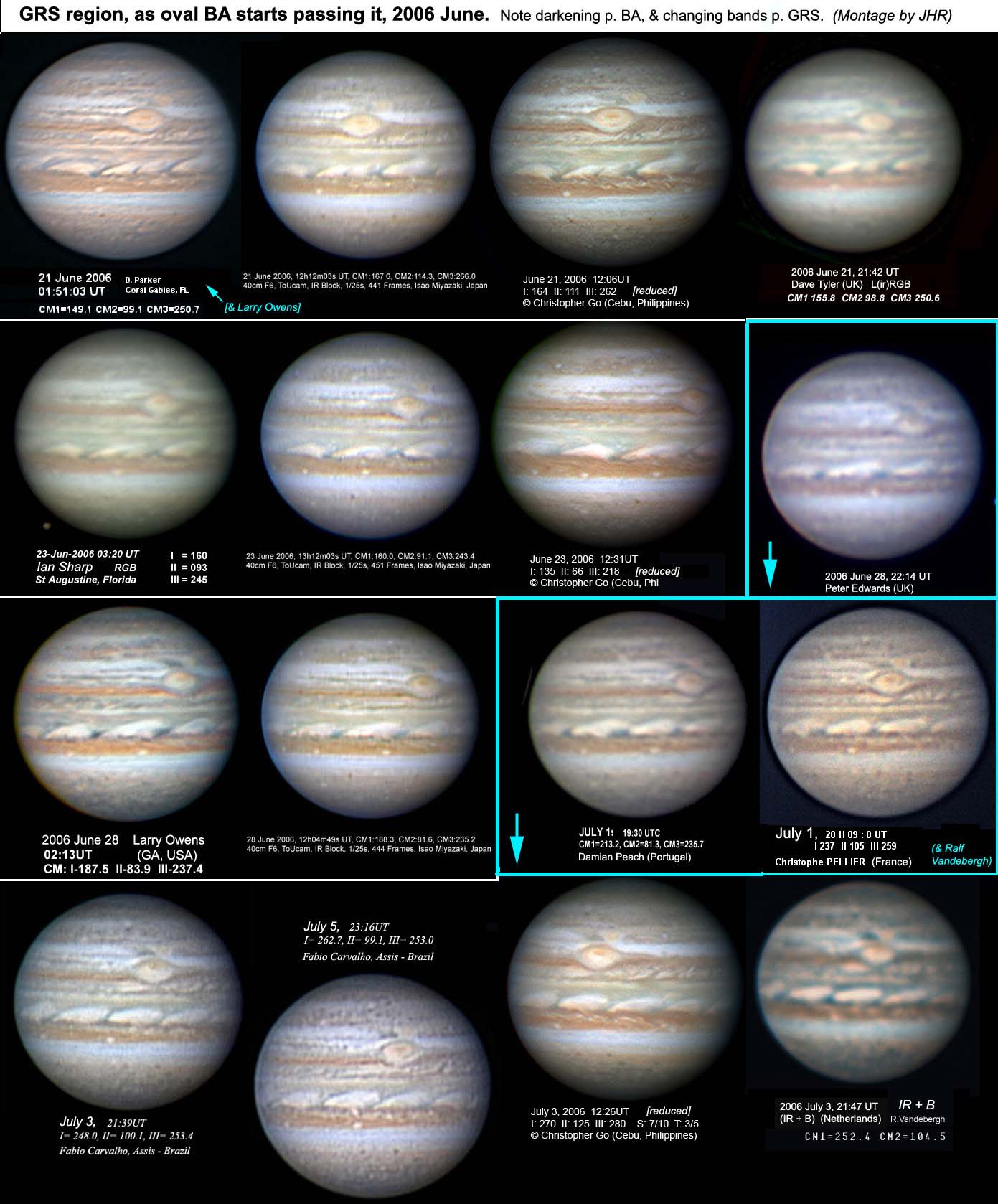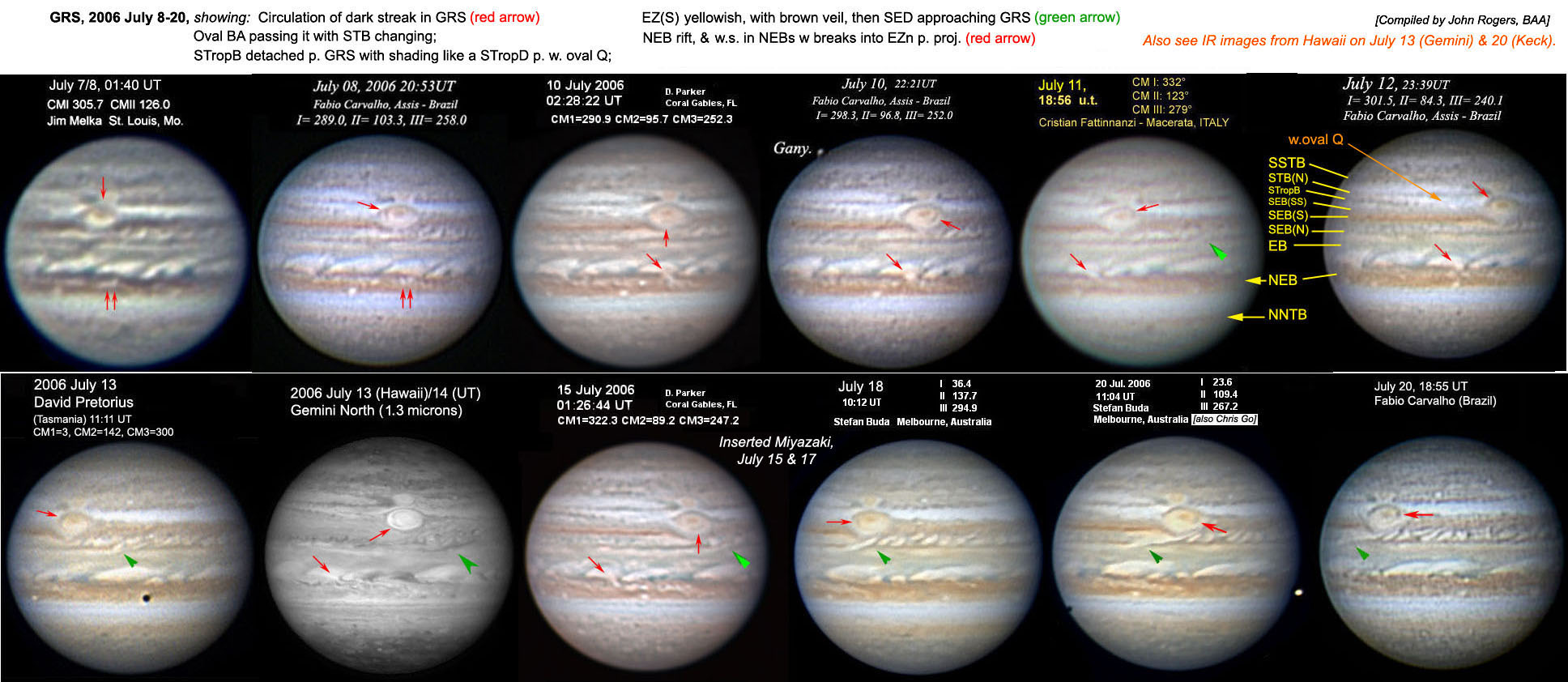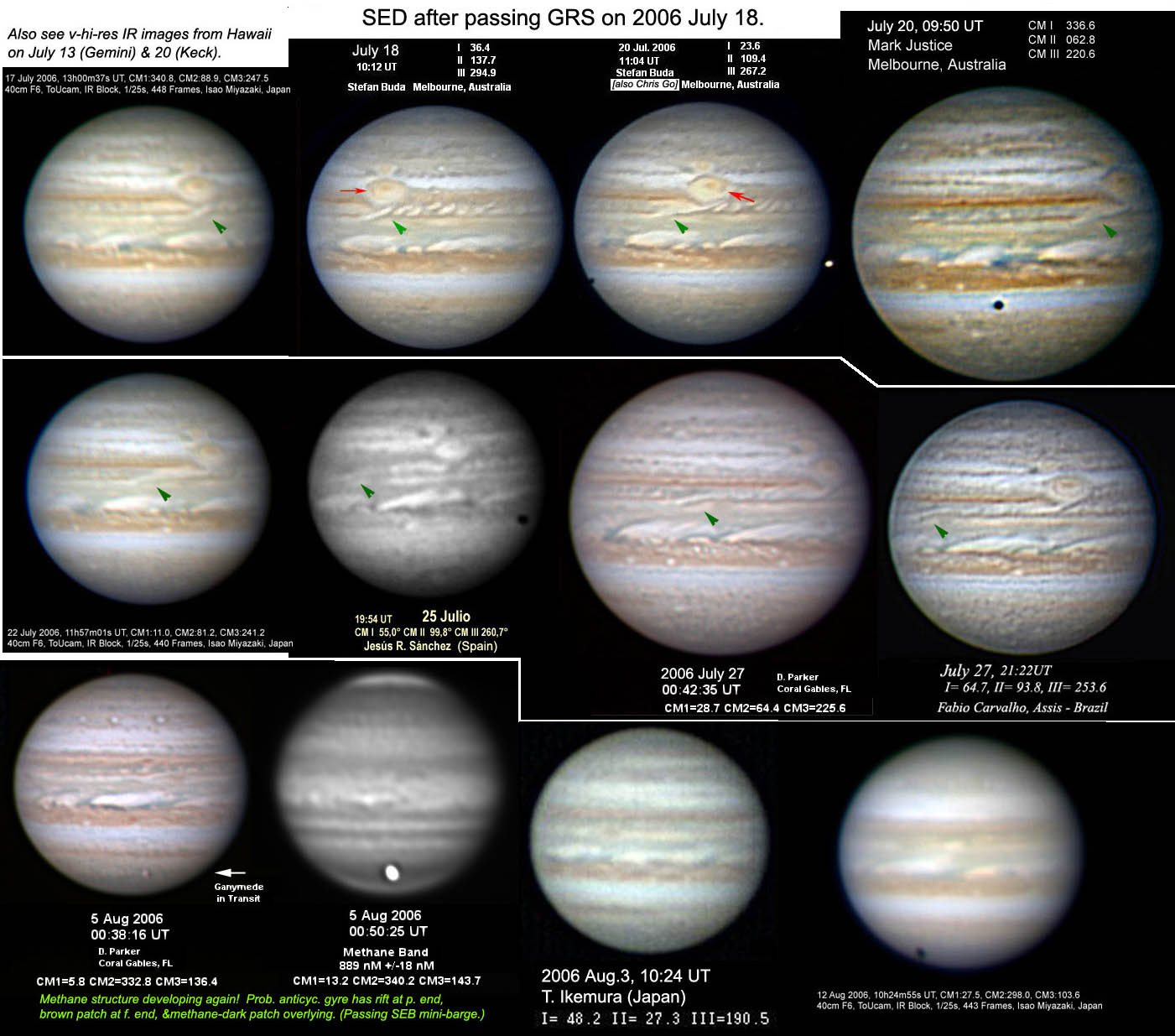
[9] Interim reports on STB (Oval BA passing GRS), STropB, GRS (internal rotation measured), EZ( S. Eq. Disturbance; dramatic darkening; NEB interactions), & NNTB: (Report, 2006 July 30)


Belts are labelled on the image of July 12 the narrow bands p. the GRS may
be quite confusing! (My designation SEB(SS) is unofficial but seems necessary.)
You
can no doubt see many interesting motions in these images which I won't discuss,
for example in the bright rifts in the SEB f. the GRS.
Also
see the superb adaptive-optics near-infrared images from Hawaii (Gemini on July
13/14 and Keck on July 20/21). The 1.3-1.6 micron channel is similar to red
light; 1.65 microns is a methane band. Web links were provided by Chris Go, viz:
http://www.gemini.edu/jupiter06
http://www.keckobservatory.org/article.php?id=88
STB:
Oval BA's red ring is unscathed as it drifts past the GRS:
Oval
BA marks the p. end of the only large dark sector of STB: this is the major
complex of activity in this domain.
Note
that p. oval BA, the STB is largely faint (white) except for a narrow STB(N),
which is probably composed of small dark spots prograding from the active
complex in the STBn jet stream. (See
the Cassini movie for a dramatic view of the dynamics in this region, showing
how the active complex emits dark spots on al adjacent jetstreams.)
This STB(N) has become longer and darker since oval BA started passing
the GRS.
As
it started to pass the GRS, the whitened STB immediately p. oval BA dramatically
turned very dark (see images of June 21July 7).
But since then, the dark patch has become smaller again (July 8-27).
Albedo
changes like this are quite common as these great S. Temperate ovals pass the
GRS, as the compression of jetstreams here clearly destabilises the cloud
layers.
However
no change was expected to the internal circulation of oval BA, and there has
been no change in its colour: the orange ring is still a striking feature in hi-res
images (as of July 27).
STropZ:
South Tropical Band progrades p. the GRS:
The
S. Trop. Band detached from the p. end of the GRS around July 1, and continues
to prograde; it is now strikingly oblique in latitude.
Oval
Q is now a very small white spot (arrowed on the July 12 image), and is
stationary relative to the GRS, so we will not see them merge in this
apparition.
GRS:
Direct measurement of the internal rotation period confirms acceleration:
This
is an amazing testament to the quality of your images: due to the number of
international observers, the high resolution of images, and the fortunate
presence of some distinct dark streaks inside the GRS, we can produce the
first ground-based measurements of its internal circulation period since it was
first measured by professional photography in the 1960s. And we find that the
circulation period has speeded up a lot! This
is being written up as a paper for the Journal
of the BAA.
Since
the 1960s, only spacecraft images have been able to track the GRS circulation,
and they have shown the period to be shortening largely due to the gradual
shrinkage of the GRS, but also recently due to a real acceleration of the winds
in 2000 (Galileo Orbiter data; Simon-Miller et al., 2002).
The shrinkage of the GRS in longitude is part of a long-term trend since
the 19th century, and I suspect this GRS is actually a new one that
arose in the 18th century. Cassini's spot in 1665-1713 was an old
one, and showed the condition towards which the present GRS is evolving (see my
book pp.188-196 and pp.262-264).
In
2006, your images have shown dark streaks rotating inside the GRS in April
(already reported), June 21 (see first set of images), and July (see second set
of images). I have plotted the position angle of the dark streak against time,
and derived the following rotation periods:
Dates
Short intervals
Longest interval No. of rotations
April
12-24 5.0
5.5 d
4.4 d
2.8
June
21
(~4.2 d
)
0.2
July
8-20
4.8 5.2 d 4.5
d
2.9
The
circulation rate seems to vary somewhat around the GRS, but I think the mean
period measured over the longest intervals is most reliable, 4.4 4.5 days.
Of course with these images we cannot be certain that we are measuring the
physical rotation rate, as the streak could be a wave propagating at a different
speed, but it agrees well with spacecraft data. It confirms that the period has
shortened since the Voyager images which gave a period of 6-8 days, both from
tracking distinct features like these, and from mapping the wind speeds.

This
shortening of period is proportional to the shortening of the length of the GRS,
so it does not confirm that the wind speeds within it have increased; however,
that could still be the case as the streaks we track may not represent the most
rapidly-circulating radius in the GRS.
EZ(S),
SEBn: Colour change, and revival of
the S. Equatorial Disturbance (SED).
As
previously noted, the narrow EZ(S) has gradually changed from brilliant white to
a yellowish colour during 2006 (thus it is also now dark in UV images).
In late June, 3 dusky grey-brown veils were noted equally spaced around
it, which were unusual features for this latitude. They were at L1 = 30, 150,
and 282 (July 1).
The
first one was associated with the long-lived SED, as tracked by Hans-Joerg
Mettig. (We are now writing another paper about the recent dynamics of the SED).
When
most active, the SED is distinguished by a bright rift in the SEBn, and this was
recorded passing the GRS on June 2 and July 18. In late June this rift was
sometimes detectable just p. the grey-brown veil at L1=30. In mid-July the rift broke through more clearly ~20 deg.
further p., at L1 ~ 0-10. Unusually, this rift broke through as it approached
the GRS alongside the turbulent SEBZ but it did become even stronger as it
passed the GRS on July 18. Its
linkage to the bright SEBZ rifts confirms observations made by Voyager and may
be a source of energy to sustain the SED. Its persistence thereafter is shown
in:

Very
recently, a whole chain of bright rifts and dark streaks has appeared on SEBn p.
another of the brown veils (July 26, CM1=249, Don Parker; see montage below:
Click for full version.
EB,
EZ(N), NEBs: Dramatic darkening,
and interactions with NEB thunderstorms.
It
is notable this year that dark features are accumulating all across the EZ.
Most obviously, the bluish-grey festoons in EZ(N) and the EB have become
much bigger and darker.
The
EB is very broad and quite dark. Some
images suggest a greenish colour!but this is not confirmed by colour
sampling, which suggests that it is really grey (though depending on the overall
colour balance of the image). Any
greenish impression is either due to visual contrast with the adjacent yellowish
EZ(S) and bluish EZ(N) festoons, or due to actual mixing of these colours.
In EZ(N) the dark festoons are attached to the even darker blue-grey NEBs projections, which are now numerous and intense. They are also fixed in L1, i.e. they have returned to a normal drift rate after the exceptionally slow drift rates (positive DL1) of the last few years. All this represents a reversion to the state last seen in 1999.

The
montage from July 8-20
shows an interesting interaction involving small white spots
associated with rifts in the NEB, first pointed out by Fabio Carvalho.
These white spots are known to be thunderstorms. Note
how one of a pair of bright white spots in the southern NEB (red arrows) breaks
through into the EZ(N) at the p. edge of a dark projection, establishing a new
rift. Such events have been seen on other dates, including one in the Cassini
movie in 2000. The interaction strongly resembles the way the SEB rifts coupled
to the SED in the same sequence of images.
NNTB:
Trace of 'red smoke'
persists:
The
diffuse reddish patch left by the disappearance of the dark NNTB 'barge' was
still faintly visible at L2 ~135 in some images in June and July, esp. by Chris
Go.
John
Rogers, 2006 July 30
__________________________